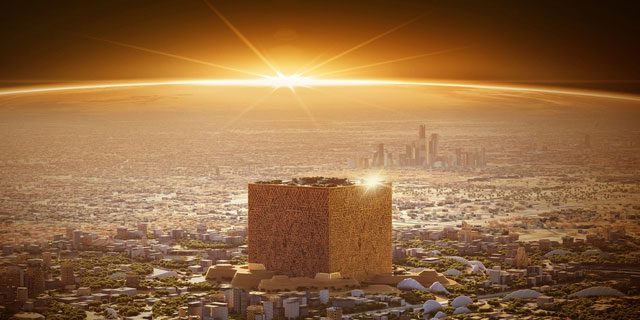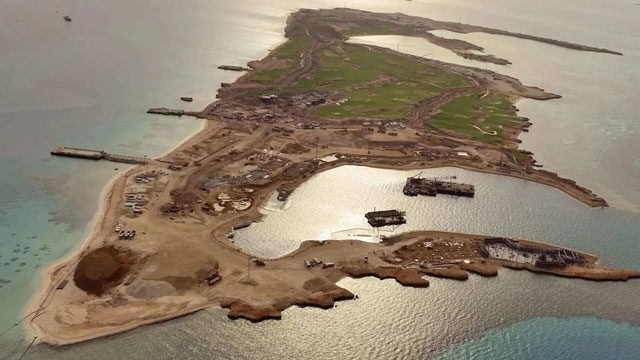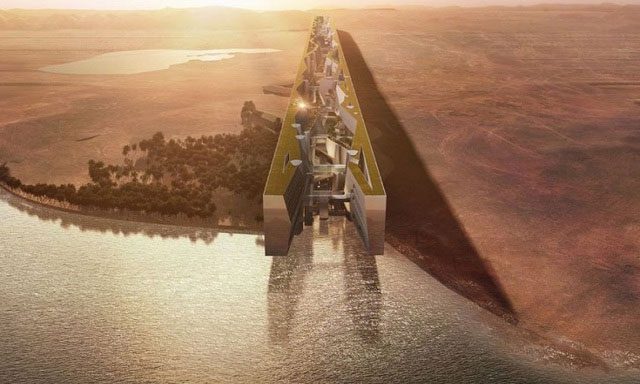Not only featuring unique architecture, these two mega-projects from Saudi Arabia also integrate numerous technological advancements and sustainability.
Mukaab – An Incredible Mega Project
This is Saudi Arabia’s ambitious mega project. Mukaab is being constructed in New Murabba, the central district of the capital, Riyadh. The significance of the project lies in its potential to reduce Saudi Arabia’s dependence on oil. Furthermore, this initiative will pioneer sustainability efforts.
According to announcements from Saudi Arabia, the new Mukaab project will be built based on sustainable concepts and is expected to contribute approximately $47 billion to the non-oil GDP of Saudi Arabia.
Mukaab also demonstrates the importance of the Vision 2030 initiative, which aims to diversify the Saudi economy and develop public service sectors such as healthcare, education, infrastructure, entertainment, and tourism.
Accordingly, this project focuses on sustainable neighborhoods, providing residents in each area access to housing, employment, and recreational opportunities within a 15-minute walking distance.
The Mukaab project aims to create a geographic region rather than a completely new city. Therefore, the possibility of commuting within such a vast network is high. Through public transportation, these living spaces will be connected to 100,000 housing units and 9,000 hotel rooms, along with community facilities.
So, the question arises: will the project’s focus on building smart living spaces be enough to make it iconic?
The answer is no.

The centerpiece of this project is a cubic skyscraper. (Photo: Archdaily)
In reality, the centerpiece of the Mukaab project is a state-of-the-art skyscraper, projected to be 400 meters in length, width, and height. This structure resembles the Kaaba in its cubic shape. However, this building is nearly 30 times larger than the Kaaba.
The Saudi government has also stated that, while Mukaab is not related to the Kaaba, the shapes of the two buildings are quite similar.
Riyadh is often seen as the modern face of Saudi Arabia. Therefore, this project represents a new opportunity to modernize the kingdom. In terms of scale, Mukaab could accommodate 20 Empire State Buildings (New York, USA) within it.
Notably, the AI Najdi architectural style will be used for constructing the building. This style reflects the architecture of Najd, the historical capital of the ancient Al-Saud dynasty. This also means that the design will incorporate elements mimicking the riverside villages of Saudi Arabia, with densely populated clusters separated by narrow pathways to shield residents from the harsh sun.
Mukaab is indeed a contender for one of the most iconic structures of the future, providing a blueprint for a new style of urbanization.
NEOM – A Mega City Integrating Advanced Technology
In addition, Saudi Arabia is merging technological initiatives with sustainability in construction projects across the desert. This integration applies not only to the Mukaab project but also to the NEOM project.
Specifically, the NEOM project will feature a mountain for winter sports and a farm for animals to live in their natural habitat. Additionally, this mega project will include a developing commercial center.
Built on the principles of nature conservation, NEOM allows wildlife to thrive in the wilderness while providing luxurious living spaces on an island named Sindalah.
This design aims to connect residents from all professions and lifestyles. Notably, the NEOM mega project will feature a city center known as Oxagon, dedicated to advanced industries and natural simulations.
NEOM promises to create groundbreaking applications in technology, enabling the creation of sustainable living spaces for the future.
According to Mr. Nadhmi Al-Nasr, CEO of NEOM, the project is progressing on schedule. Currently, four large complexes of NEOM, including Sindalah Island, The Line, Trojena, and Oxagon, are under construction.

NEOM is on schedule. (Photo: NEOM).
Specifically, Sindalah is a resort featuring a beach club, golf course, spa, fitness center, and hotels. The advanced architecture, technology, design, and perfect climate at Sindalah promise enjoyment for its residents.

The Line is a linear city capable of housing 9 million people. (Photo: WSJ).
The Line is a smart city operating on 100% renewable energy, with 95% of the land area preserved for nature. Unlike traditional cities, the health and happiness of residents in The Line will be prioritized.
Notably, residents of this city can access all amenities within 20 minutes, thanks to high-speed rail connecting both ends of the city. The Line can accommodate 9 million people, stretching 200 meters wide, approximately 170 kilometers long, and standing 500 meters above sea level.
Trojena is a resort within the NEOM mega project, located about 50 kilometers from the coast of the Gulf of Aqaba. This area is situated at an elevation ranging from 1,500 m to 2,600 m and covers nearly 60km2.
Leveraging the different climatic advantages in the region, where winter temperatures drop below 0°C and the annual temperature is often more than 10°C cooler than the rest of the region, Trojena will not only be an enchanting destination for outdoor skiing but also a wonderful place to live and work.
Lastly, Oxagon is a city designed in an octagonal shape located on the outskirts of NEOM. This city will harmoniously integrate technology with nature and will be one of the most advanced technology hubs in the world.
Oxagon will implement cutting-edge technologies such as the Internet of Things (IoT), predictive artificial intelligence, and the integration of humans, machines, and robotics.


















































